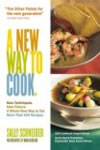A New Way To Cook
How My Cooking Has Changed : part 3
I happened across Sally Schneider's A New Way To Cook
in a chain bookstore one day, just about three years ago. It's very big and very broad, and The Joy of Cooking is clearly not far from its mind.
But while Joy of Cooking is a vast collection of recipes, A New Way To Cook is trying to explain a much smaller core of ideas, expressed in the form of recipes with variations. We have, for example, a core recipe for "braising small fish" or "rustic fruit tart", and then examine a host of ingredients that we can add or subtract -- and the changes that these additions and subtractions will require. In the fruit tart, for example, we might use apples or pears or strawberries (less water, more flour, add rhubarb) or blueberries (try a little thyme) or raspberries (even frozen -- add more flour because they're wet) or reconstituted dried apricots. It's all the same idea.
And that's a powerful idea, especially because a generation of home cooks raised to respect recipes can easily forget how forgiving food can be. Some things (baking) must be measured and timed, but tasty ingredients are bound to taste good whatever you do.
Schneider also recognizes that a generation of US cooks have grown up with a weird, religious antipathy to fat, which became to us what unclean foods were to our ancestors. But fat is also one of the things that makes food worth eating. It can make you crazy.
Schneider solves this brilliantly: fat's just an ingredient. An expensive ingredient. You aren't going to eat lots of fat, so you've got to make it count: you want the fat you eat to be the tastiest, freshest, most wonderful fat you can get. Schneider has you hoarding the fat from your duck, to be doled out carefully over weeks or months for cooking potatoes. You use less fat because you'll run out, and you really enjoy the fat you use.
